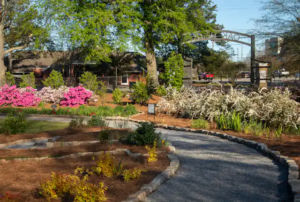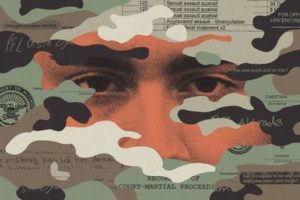New research at Tantura includes the analysis of historical aerial photographs and testimonies from eyewitnesses during the 1948 war, but it’s not yet clear if a massacre really took place

The Tantura area in 1948.
Jehan Sarhan drove down to Dor Beach south of Haifa on Tuesday. She stopped at a certain spot in the parking lot, got out, laid flowers and read a few verses from the Quran.
The Arab village of Tantura was once there, but exactly 75 years earlier, on May 23, 1948, it was taken by the Haganah, the Jewish forces fighting in Israel’s War of Independence, just days before that army would be renamed the Israel Defense Forces.
The village had 1,500 residents. Sarhan’s mother, Al-Hajja Rashida A’amar, was one of them. After the village fell, she was expelled with the other the women, children and elderly. She was 18. Her first husband, Mohammed Ahsan A’amar, had been killed.
The family considers him a shahid, a martyr, and says he was killed in a massacre by Israeli soldiers. Israel does not recognize that a massacre took place. Historians are also divided, and if a massacre did occur, the size is not yet clear. It’s also unclear if the victims included villagers or only armed fighters.
This week, Sarhan visited the site as part of an event organized by Sami al-Ali, 42, a member of a new organization that commemorates the village and the people there.
“We’re creating a precedent here, for the first time since the Nakba,” he says, referring to the events of the 1947-49 war, when 700,000 Arabs fled or were expelled from their homes. “We came to Tantura to mark the sites of the mass graves.”
Members of the group left flowers, stones and a ribbon connecting them. In the future, they hope to fence off the area and put up a monument.
“We took one step toward recognition of the massacre,” al-Ali says. “If the state doesn’t officially recognize it, we won’t get anywhere. We won’t be able to move forward toward reconciliation and peace.”
- The Tantura myth: Why didn’t Palestinian villagers ever mention a massacre?
- How to cover up a massacre
- The Ghosts of Tantura
According to a new study, four mass graves lie under the site. The researchers could not confirm or refute that a massacre of villagers took place, but they say some residents may be buried there.

The study was conducted by Forensic Architecture, a research group at Goldsmiths, University of London, under Israeli architect Eyal Weizman. The group uses highly advanced technology to document human rights violations around the world, with the findings sometimes serving as evidence in court. Forensic Architecture’s researchers say they located mass graves at Tantura by comparing historical aerial photos to current ones.
They also collected testimonies, created computerized models and conducted a land survey, also noting the few buildings remaining in the village.
According to the study, two mass graves are under the beach’s parking lot, with one perhaps containing 70 to 140 bodies, the other 40 to 80 bodies. A third mass grave is believed to lie where the village’s main Muslim cemetery once was, with the fourth on the beach. The Adalah rights group, which initiated the study, wants the authorities to fence off these sites and place signs there.

“The findings are fairly clear and there is plenty of evidence,” says Suhad Bishara, the head of Adalah’s legal department. “We’re asking for an end to the desecration of graves, allowing the families of the dead access to the site. This is a recognized right in court rulings; it’s not something complicated if there’s the will.”
This week she sent a letter on the matter to the relevant Israeli authorities. Adalah will not demand that the graves be opened. “At this time, no,” Bishara says. “This process needs to be undertaken with the families, and it’s not easy.”
‘Maybe one day we’ll be friends again’
Forensic Architecture also relied on oral and written testimonies by villagers who lived in Tantura before it fell. But the researchers could not determine if there were bones underground without opening the sites. If bones are ever found, they will have to be examined for signs of execution.
Haaretz contacted an independent expert who deciphers aerial photos; he said Forensic Architecture’s pictures were “reasonable and professionally sound.” But the expert, who requested anonymity, added that the measurements of the sites and the number of graves claimed to be there “can be argued.”


Haaretz also presented the report to Meir Bulka of J-nerations, a group that strives to preserve the Jewish heritage in Poland. It also specializes in locating graves of Jews killed during the Holocaust.
“To conclusively reach the truth, the ground must be scanned by geophysical means such as ground-penetrating radar,” Bulka says. “This kind of test will give a more highly accurate indication.”
One eyewitness the report is based on is Adnan Yahya, 92, a retired doctor who now lives in Germany. Yahya provided testimony supporting the theory that a mass grave lies under the site of the Muslim cemetery. He was 17 when the village fell.

“I didn’t take part in the fighting. They gathered many of us on the beach, in the sun, and we stood there for a few hours without food or water. Then they took us all to the cemetery,” he told Haaretz, adding that a pit was dug where the people were told to throw the bodies of village residents.
“We threw bodies there and also people who were still half alive,” Yahya says. “Abdullah, my friend from school, held his father’s legs, and I [held] his arms. And then he said to me: ‘Adnan, he’s still alive, what should we do?’ I told him: ‘Throw him in, he’ll die.”

Yahya says most of the dead were young men, but some were older and a few were women. Later he was detained by Israeli forces. “They called me a prisoner of war, even though I didn’t know how to use a gun,” he says. “They took us to detention in Zamarin in Zichron Yaakov, whose residents were actually friends of ours.”
He was then transferred to a military camp elsewhere, and he later moved to Syria and Kuwait, where he worked as a teacher. In 1975 he emigrated to Germany, where he studied medicine, became an ear, nose and throat specialist and started a family.
Yahya returned to Tantura decades later as a tourist. “I saw the fields that belonged to my father,” he says. “He was very rich when it came to land. But everything is gone. Don’t view the Palestinians as terrorists; we’re people like everybody else, who just want to live on their land. Maybe one day we’ll be friends again.”
A tour on the ground this week also included a visit to the cemetery site that Yahya described. “Today there’s a lawn there,” says al-Ali, the member of the organization that commemorates Tantura. “They did everything to erase the memory of the cemetery. It’s vulgar desecration.”
His grandfather, Dib al-Ali Jourban, lived in Tantura when it fell and was arrested by the soldiers. His uncle, Anis Dib al-Ali Jourban, who was 18, was saved from certain death, al-Ali says.

“They wanted to shoot him, but the bullet didn’t leave the barrel, al-Ali says. “The soldier tried once, twice and three times, and in the end my grandfather, according to his testimony, got up and said that if God didn’t want him to die, you couldn’t insist. That’s how he was saved. Out of fear, the hair on his head turned white at an early age.”
Speaking with Forensic Architecture, some witnesses could give an exact location of a mass grave, for example, “in the Dassouki family’s orchard.” In other cases, mentions of bushes and trees could be cross-checked with the aerial photographs. For example: “They took us from the beach to a place next to the cemetery; they gathered us together next to the cactus plants,” Saud Abu Hana said.
Mostafa al-Masry said: “There were three trees there; 30 meters north of there they dug a pit, which was surrounded by piles of dirt.” Someone else said: “We arranged [the bodies] like sardines, in a first row, in a second row.”
Last year the affair made headlines with the release of the documentary “Tantura” by Alon Schwarz. According to the film, a mass grave sits under the Dor Beach parking lot. Experts compared aerial photographs from before and after the village’s capture; Schwarz also suspects that bodies were removed from a grave. Forensic Architecture, however, says that none of the visual evidence suggests this.

A historical dispute
According to the UN Partition Plan approved on November 29, 1947, Tantura was included in the territory of the Jewish state. On May 23, nine days after the State of Israel was declared, the village was captured by the Haganah’s Alexandroni Brigade. The Arab residents lost their homes and land along the coast.
Pictures taken in Tantura when it was captured show soldiers separating the men from the women, children and the elderly. The men were detained while the others were expelled to the nearby town of Fureidis. After about three weeks some of them were sent to Tul Karm, which was under Jordanian control and is now in the West Bank.
“After a fierce battle, on Saturday night our forces captured the village of Tantura near Zichron Yaakov. Hundreds of armed Arabs were taken prisoner and a great quantity of weapons fell into the hands of our forces,” Haaretz reported on May 24, 1948.
“Recently, the village had become a naval base for the enemy, who smuggled arms and people through it into Israel. The village, which was fortified, was captured after it was surrounded by the Hebrew army.”

This article, one of the first about events in Tantura, also included some interesting numbers: “Our losses were light. Heavy losses were caused to the enemy: 40 dead and many wounded. The women and children were moved by our soldiers from Tantura to the village of Fureidis and Zichron Yaakov.
Various sources since have said that anywhere between 20 to over 200 Arab residents were killed. Fourteen Israeli soldiers were killed.
Forensic Architecture received reports about an execution by Israeli soldiers. “They would take young men and make them stand facing the wall, then fire at them. I witnessed it with my own eyes,” Ahman Abdel Mo’ty said in a video published by Forensic Architecture.
Mohammad Ibrahim Abu Amer said in a video: “They would take them 20 meters or so away, inside the alleyways of the neighborhood, tell them to face the wall, and shoot them. Within one or two hours, they had killed 60 to 70 men.”

The first person to suggest that a massacre might have taken place at Tantura was Theodore “Teddy” Katz, a student who in 1998 wrote a master’s thesis at the University of Haifa. After his findings were published in the newspaper Maariv, causing an uproar, veterans of the Alexandroni Brigade sued Katz for libel. The thesis was found to contain methodological flaws and received a failing grade after it had originally received a 97.
Critics have accused Katz of committing a “blood libel.” Last year, the University of Haifa’s rector, Prof. Gur Alroey, harshly criticized Katz’s work and the faculty members who approved it. Katz “made every possible mistake and lacked basic training. His work included crucial flaws,” Alroey said, adding that faculty members used Katz’s research “to advance their political agenda.”
Other historians who study the Israeli-Palestinian conflict, including Benny Morris and Yoav Gelber, do not believe that a massacre took place at Tantura. They say no reliable evidence exists from the time around when a massacre allegedly occurred, and they are very skeptical about evidence from much later periods.
In a Haaretz article from January 2022, historian Adam Raz from the Akevot Institute for Israeli-Palestinian Conflict Research collected the harshest evidence on the existence of a massacre at Tantura. One soldier said, “It mustn’t be told, it could cause a whole scandal. I don’t want to talk about it, but it happened. What can you do? It happened.”
Another told how a soldier went up to a group of 15 or 20 prisoners and “killed them all.” Another told of an officer who later was a key figure in the Defense Ministry: “With his pistol he killed one Arab after another.”

Another soldier described a different incident there: “It’s not nice to say this. They put them into a barrel and shot them in the barrel. I remember the blood in the barrel.” Another soldier said his comrades didn’t behave like human beings in the village.
Raz also quoted a statement by a Palestinian, who wrote: “Soldiers ordered five young men from the village to collect the bodies from the streets of the village, as they did earlier in another case, and transported [the five] in trucks to the pit.” After the collection of the bodies, “the five men were stood on the edge of the pit with their faces toward the bodies. After that, one of the Haganah officers came and shot them in the back from behind, and they fell into the pit on the bodies of their friends.”
Testimony about bodies
Neither side denies that after Tantura fell, the bodies of some of its residents were buried there. Evidence of this exists in documents in the Israeli military’s archives. One document says many bodies piled up there and it took a long time to bury them.
The regional commander wrote in a document to a subordinate on May 29, 1948, six days after the village was captured: “Take care to bury the bodies of the Arabs in Tantura and prevent a plague. On June 9, a document stated: “To the regional commander. I checked the mass grave in the Tantura cemetery yesterday. I found that everything was okay.”
The plight of the Tantura residents who were driven to Tul Karm was described on June 20, 1948, by Haaretz journalist Shimon Samet. He noted the “astonishing traffic of dozens of Dan and Egged vehicles packed with Arab women of various ages … a great number of babies and children as well as a few old Arabs.”
When the convoy reached the Tul Karm area,“the migration of a thousand people began, among them old people, disabled people and babies, on side paths over fields and sand trails,” Samet wrote.
Historian Prof. Alon Confino wrote in 2013 that the “village served as a good base for building a new and flourishing community, Kibbutz Nahsholim.” But “most of the property that was abandoned at the site was looted by the soldiers and residents of Zichron Yaakov.”
Haim Gvati, a later agriculture minister, wrote that Tantura was a lovely little place, but “it has just one disadvantage. None of this is ours.”




